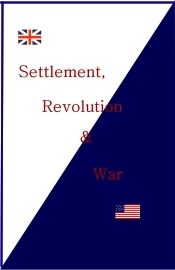
 Book #2: Settlement, Revolution & War.
Book #2: Settlement, Revolution & War.
On square-riggers, such as the Shannon and the Chesapeake, sails are hung from yardarms, horizontal sticks on vertical poles (masts). Once dropped by the seamen from the yardarms, the sails would flutter like so much laundry, and continue to do so until tied down at the two lower corners. Thus held, they become stiff to the wind. The tie-down lines at the two lower corners of these square sails, these long pieces of rope, are called sheets. Sheets are part of a sailing ship's running rigging, ropes (though the seaman much prefers the expression "lines") that are handled in order to either haul in or let out the numerous sails above. These lines are essential to sheet in the sails, to stiffen them, to put wind into them and thus to became the driving force of the vessel. If the sheets are let loose (an intentional act when the sailer wishes to loose speed) the affected sails return to being like so much noisy laundry as they shake in the wind. The sailing vessel will loose way (speed through the water) and on loosing way cannot be steered. The vessel is steered by a rudder in the water at the back end or stern of the vessel. A rudder is useless unless it is immersed in a current of water. If a vessel has no way on then she becomes her own free agent, and like a seagull resting on the water, will want, suddenly, and notwithstanding a sailor's wishes to the contrary, to change her direction. The direction a stopped vessel will take is predictable. Because of its dynamic shape, she will come up into the wind. She will point her nose, or bow, up into the wind. Unless some immediate corrective measures are taken, the sailing vessel will start to go backwards, stern first.
And so we see that there are critical lines called sheets, part of the running rigging of a sailing vessel. A set sail on a sailing vessel, while underway, must be tight and tied down. Now, one can be certain that all of the Chesapeake's sheets were tight and tied down as she came into battle with the Shannon. What happened was that certain of the Shannon's shots -- much to her good fortune, and much to the misfortune of the Chesapeake -- cut certain of the Chesapeake's sheets.1 So, immediately the sheets let go -- and it must have been quite a few all at once - a number of the Chesapeake's sails immediately went into their laundry like state of just shaking in the wind. Suddenly and uncontrollably she swung to her right seeking to put her nose into the wind, which, of course, would have been no great problem were she out for a pleasure sail, but she had a vessel broadside and downwind of her, a British Man of War, ready to rake with killing shot from stem to stern. Or rather, from stern to stem, which is precisely what the Shannon did.
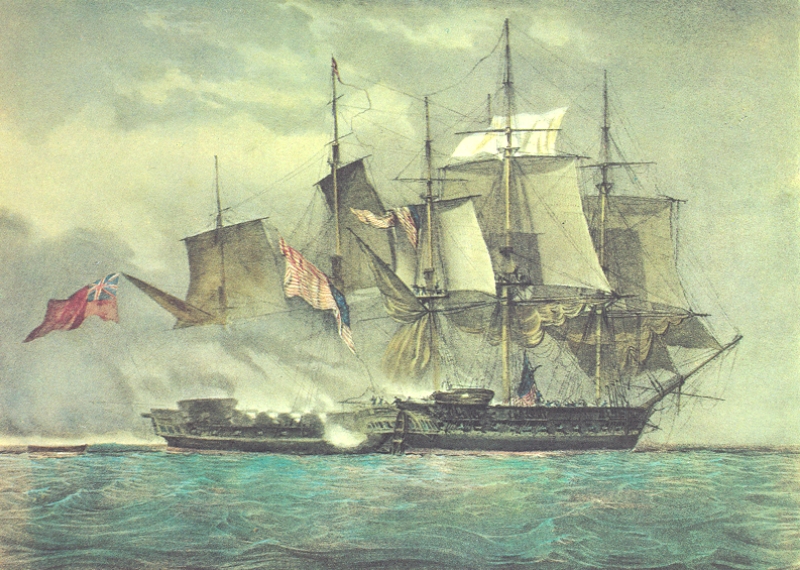
|
It should be pointed out that the Captain and his first officers are usually clustered together at the stern, the place where the steering wheel is, the command center, the quarterdeck. So it was, that many of the Chesapeake's officers were splattered to their deaths as the Shannon's iron shot carried away everything on the Chesapeake's quarter deck. "The battle at this moment was decided."2 "All in the Wind," her sails "a'shivering," the Chesapeake lost her command.
Seeing the Chesapeake in such trouble encouraged Broke to do what he could to come alongside and board her. He did not have to do much, for by now the Chesapeake was coming stern-first and soon fell foul of the Shannon. Running forward and seeing that the Americans were quitting their guns, Captain Broke seized the moment and ordered the ships lashed together, not something the Americans were very keen on, for the two British seaman doing the lashing, one being the boatswain, William Stevens, were mortally wounded with sabre cuts and by musketry.
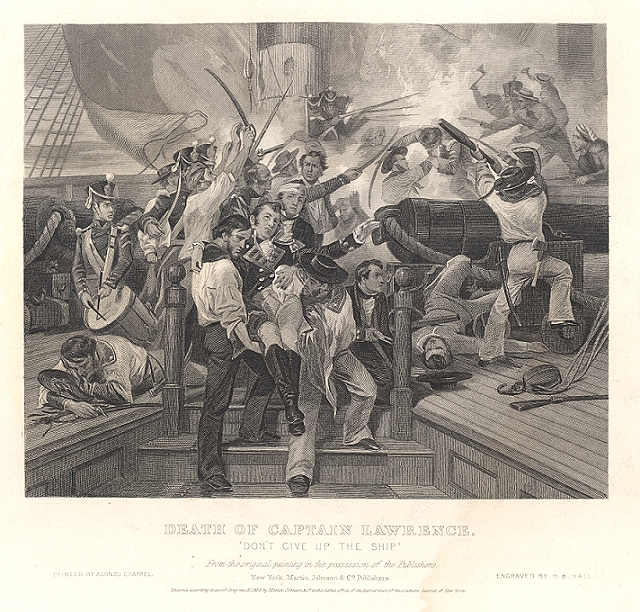
|
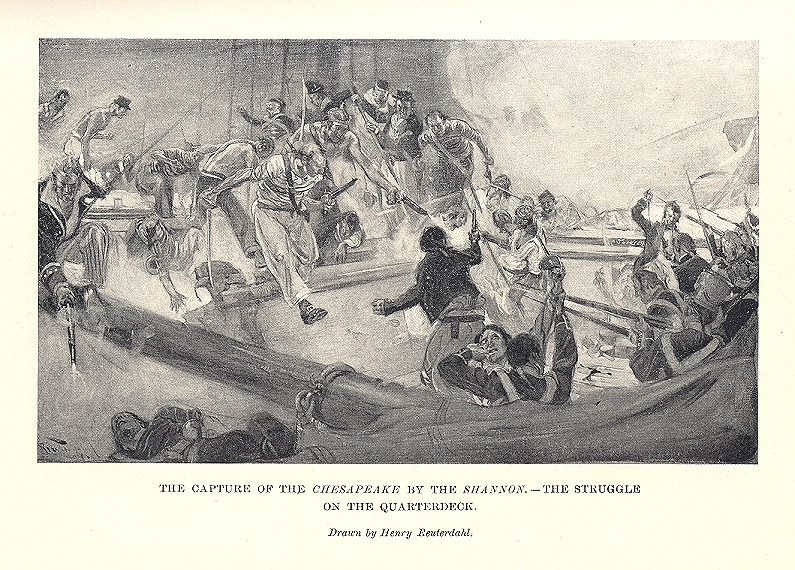
|
"In the meanwhile occasional fighting was carried on upon deck; but those on the forecastle having submitted, Captain Broke sent most of his party aft, where some opposition was still continued. About a minute or so before Mr. Smith's successful exploit, Captain Broke was in the act of giving orders to silence the fire from the enemy's tops, when the sentry, who had been placed in charge of the men that had surrendered, called out loudly to the captain, who, on turning round, found himself attacked by three Americans. Finding they were superior in number to the British, these men had resumed their arms; and as Captain Broke turned round, he parried the pike presented by the middle one of the three with his sword, and wounded him in the face, but at the same instant received a violent blow from the butt-end of a musket, which bared his skull and nearly stunned him. The third man cut at the captain with a sabre, and brought him down; and in a few second he must have been killed, when William Mindham, who has already been mentioned, with a blow from his cutlass, felled the man to the deck. Two or three of the British were also killed or wounded by the Americans who had previously accepted quarter; and it cannot cause surprise if all concerned in the proceeding fell before the indignant Britons who rushed to their captain's rescue."4
Years ago, when I was young and going to university, I was a part-time midshipman in the Canadian Navy. I recall receiving from one of the seasoned navy-men that one of the worst things a navy man could do was to foul up the business of raising the flag.5 The raising of a flag is always accompanied with much ceremony, or, at least, as much as might be allowed in the circumstances. A flag or a pennant when raised in a certain position always has a meaning to the sailors aboard. On a navy ship the raising of the country's flag is done every morning; it is lowered every evening. One of the proudest moments for fighting sailors is when -- and it is to be done as immediately it can be done -- their flag is raised on a boarded enemy ship. When a fighting man sees his country's flag being raised over the disputed territory, it spurs him on to greater efforts; it has the counter effect on the other side. I did not really appreciate that back then, when I was a midshipman, and it was to be a long time after my naval experience before I heard about the story of Lieutenant Watt and his men, and a most unfortunate mistake of theirs.
Lieutenant G. T. L. Watt was one of the first men to board the Chesapeake immediately at the heels of Captain Broke. He soon perceived that he and his brave comrades had the upper-hand over the fighting men of the Chesapeake.
One can only imagine the horrors of a close-quarter naval action. Much of the action was fought in dense smoke and darkness. If the weapons of the enemy did not directly get them, then the fall of rigging such as yardarms and masts might do the job by crushing them. During the battle, the air was thick with an infinity of savage wood splinters sent flying by the impact of the cannonballs shot through the wooden bulwarks. Projectiles of every kind imbedded themselves into human flesh; the slaughter was appalling. We have some details of the wounds suffered by the Shannons. The purser, George Aldham, grape shot in the lower part of the abdomen (lived one hour); 21 year old Able Seaman William Birbles, grape lodged in the back part of chest (lived several hours); Able Seaman Thomas Selby, head shot off; 24 year old Able Seaman James Wallace, musket ball through abdomen (lived thirteen hours); "Boy," 18 years, Thomas Barry, cut in two by a star shot7; Private James Jaynes (Marine), grape shot in the belly; Boatswain Stevens, struck in the left forearm by a grape shot, and a musket shot lodged in the left side of the pelvis; Private Dan Neil (Marine), splinter wound in the breast, several sabre wounds, bayonet wound in the belly -- the list of these men and their awful wounds goes on and on. Upwards of a 100 men on both sides who died on account of this twelve minute battle, all with the same sort of dreadful wounds.8
Captain Broke wrote in his report:
The British version was that the damages to the Shannon were trifling10, "she had taken some shots through her hull, and her lower masts and shrouds were badly wounded, and much cut." Out of 306 men and twenty-four boys, twenty-four were killed and fifty-nine wounded, Captain Broke severely so. The Chesapeake, again, according to the British, "in her short action, had received much damage ... Her loss in killed and wounded was very severe ... forty-seven killed and 106 wounded, fourteen mortally."11
Sufficient repairs having been soon effected, the two combatants, now at peace under one command12, set off to sea. The two ships sailed together northeast into friendly waters. Five days later, on June 6th, signals were received and repeated. A gun went off on Citadel Hill at Halifax and flags were raised to indicate that there were two warships in the offing. It was Sunday morning and many of the Halifax residents were in their finest, attending services at St. Paul's. The news spread fast and a crowd soon gathered on the harbour front. The crews of several British warships already in the harbour mounted the ratlines and the crosstrees of the towering masts. Loud cheers went up from the crews of the ships and from the crowds lining the shore. The Shannon came proudly up Halifax harbour. She had in company one of "the far-famed frigates." The Shannon brought the Chesapeake home as a prize-of-war.
John Liddell, a merchant at Halifax, wrote in his journal, "June 6th, 1813: Arrived HMS Shannon Capt Broke with the US Frigate Chesapeake Capt Lawrence her prize."13 Liddell gives details:
The American crew was as well treated as the British, with the wounded being cared for in the naval hospital. On June 25th, an American ship, the Frederick Augustus carried a number of sick and wounded prisoners to Boston.18 On August 10th, the American Brig Henry came in under a white flag. She came up from Boston as a cartel requested it be allowed to take the body of Captain Lawrence19 late of the Chesapeake. Within days, the Henry sailed for Boston with the body of their hero together with a number of prisoners.20 Though it seems the sick and the wounded were sent back to their homes within a few weeks, Melville Island Prison21 at Halifax was to keep the healthier ones for awhile. They were processed and a determination was made whether the individual was a British seaman (read "deserter"), or, if an American, was he one that had been previously captured and released on his undertaking not to bear arms for the duration. One hundred and one of these American prisoners22 fitted into one of these two categories. They were put aboard the two war vessels which were en flute, being the Regulus23 (meant for 44 guns) and the Melpomene (meant for 38 guns). On September 5th, the two left for England.24 The very same day, incidently, that the Shannon, Captain Teahouse, set out on a cruise.25 For the Shannon it was a short cruise, for we see that on October 4th, the Shannon sailed with the fleet for England. Captain Broke, still suffering from his wounds, was back aboard his Shannon headed for home and full of glory; they arrived at Portsmouth on the 2nd of November.
Before he left, Captain Broke was honoured by the people of Nova Scotia by the gift to him of "a piece of plate, which he accepted graciously."26 Back in England, he was fêted as a conquering hero by all. Lawrence came out of it a dead hero. The American memory of him is a good one, except there were a number of criticisms of the manner in which Lawrence had proceeded that day. Principal among them was that he went out with an "untrained crew and raw officers," more generally that he had picked a fight before he had worked his men up into a team.27
"Lieutenant Watt having procured an English ensign from the Shannon, after hauling down the American flag, bent both on to the halyards, intending to hoist the British above the American; but the halyards being foul, the American flag became the uppermost. This was instantly perceived from the Shannon's quarterdeck; and as the two ships had separated a little, owing to the quarter-gallery of the Chesapeake having given way, the idea that the British had been unsuccessful occurred, and the firing recommenced. The mistake in the flags being discovered almost immediately, was of course rectified, and the Shannon's firing ceased, but not until Lieutenant Watt and four or five of his men were killed."6
Within a quarter of an hour after it started with resounding cannon, all was quiet except for the groans of the wounded seamen.
"I took a position between cape Ann and cape Cod, and then hove to for him to join us. The enemy came down in a very handsome manner, having three American ensigns flying: when, closing with us, he sent down his royal yards. I kept the Shannon's up, expecting the breeze would die away. At half-past, 5, p.m., the enemy hauled up within hail of us on the starboard side, and the battle began, both ships steering full under the topsails. After exchanging between two and three broadsides, the enemy's ship fell on board of us, her mizen channels locking in with our fore rigging. I went forward to ascertain her position, and observing that the enemy were flinching from their guns, I gave orders to prepare for boarding. Our gallant hands appointed to that service immediately rushed in, under their respective officers, upon the enemy's decks, driving everything before them with irresistible fury. The enemy make a desperate but disorderly resistance. The firing continued at all the gangways, and between the tops, but in two minutes' time the enemy were driven, sword in hand, from every post. The American flag was hauled down, and the proud old British union floated triumphantly over it. In another minute they ceased firing from below, and called for quarter. The whole of this service was achieved in fifteen minutes from the commencement of the action."9
The Shannon and the Chesapeake had only exchanged twelve minutes' worth of cannon fire. Before the end of that twelve minutes, Captain Broke and his men were on the deck of the Chesapeake. Four minutes later all fighting ceased and the Chesapeake was the Shannon's prize. Not long after that Captain Broke fainted from loss of blood, and he was soon rowed over to the Shannon in the jolly-boat.
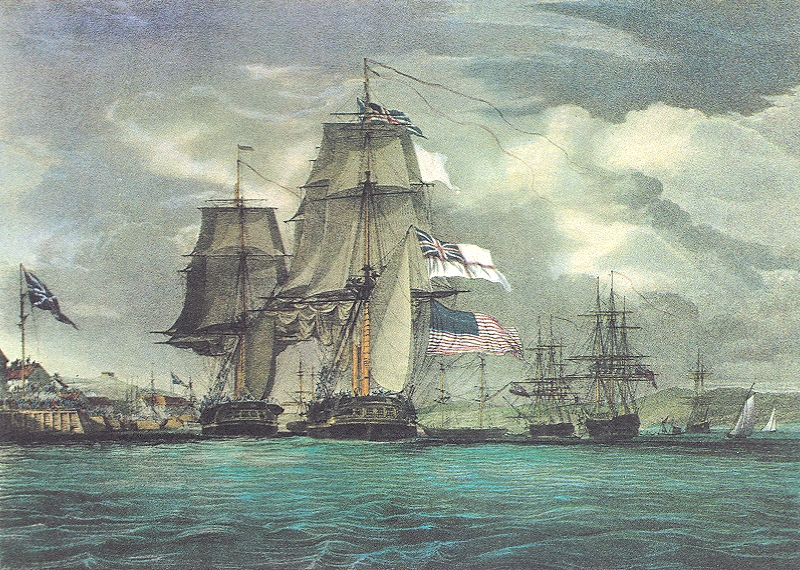
"The Shannon, in the company of her captive the Chesapeake, came proudly up Halifax harbour."
"On the 1st Int. the Chesapeake was captured by the Shannon off Boston Light after a Sanguinary action of 11 minutes, on board the Shannon the 1st Lieut. Watt, Purser Aldham Capts Clerk, Dunn & 23 seamen Killed -- Capt Broke was severely wounded, & 57 seamen. On board the Chesapeake there were about 70 Killed & 100 wounded amongst the former Capt Lawrence & latter 1st Lieut Laidlaw severely by 5 wounds -- Capt Broke was cut by a sabre in the head & had a ball through his arm & she was carried by boarding, the Capt being amongst the first on board."14
Suffering from his serious wounds in a cot while his ship was brought to Halifax, Captain Lawrence lingered for four days and died a day before Halifax was reached.
"On Tuesday, the 8 June, Captain Lawrence's remains were buried in the graveyard opposite government house. His remains were landed, under a discharge of minute guns, at the king's wharf, from whence they were followed to the grave by his own surviving officers, those of H.M. navy and army, and many respectable inhabitants of the town. On the American flag, which covered the coffin, was placed the sword, &c., of the deceased, and the pall was supported by six captains of the royal navy. A military band attended, and 300 men of the 64th regiment fired three vollies over the grave. The funeral service was performed by the rector of St. Paul's church. Nothing could be more solemn and impressive than this procession, from its landing at the king's wharf to the close."15
The naval hospital at Halifax treated the wounded, but in the next few weeks a number of them died. The Boatswain of the Shannon, William Stevens died at Halifax on June 26th.16 He was a hero. Much of the credit for Shannon's success was given to Stevens. It will be recollected that it was Stevens and another seaman who lashed the two ships together allowing Captain Broke to lead a boarding party. While lashing away, he was exposed to enemy fire. He was struck in the left forearm by a grape shot, and a musket shot lodged in the left side of the pelvis. That he lived twenty days is amazing. He was buried with considerable ceremony in the churchyard (St. Paul's) just across Barrington Street opposite the governor's house. Midshipman John Samwell was buried along with Stevens. There were five other crew members of the Shannon that died at the naval hospital from the 13th through to the 26th of June. They were buried in the old Naval Cemetery which is located within the naval base, H.M.C.S. Stadacona at Halifax.17
"Broke's victory had provided a badly needed tonic to a British public depressed by earlier American naval successes, and he was showered with honours, being made a baronet on 25 Sept. 1813 and a K.C.B. [Knight Commander of the Bath]; on 3 Jan. 1815. He was also awarded the small naval gold medal given to post-captains who had distinguished themselves in action. However, much troubled by his wound, he never served at sea again, and spent most of the rest of his life at Broke Hall. There he took a keen interest in the community and was kept busy with correspondence on naval matters, chiefly gunnery. He was promoted rear-admiral of the red on 22 July 1830. In 1840 he became concerned about his health and decided to undergo an operation in London to repair the damage from his wound. He could not stand the strain and died on 2 Jan. 1841, being buried in St Martin’s Church in Nacton seven days later."28
[NEXT: Pt. 5, Ch. 13 - "Blockade Of The Chesapeake."]
